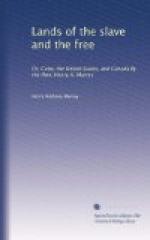The passion and the prowess of our race,
The song of Homer in its loftiest hour,
The unresisted sweep of human power,
Britannia’s trident on the azure sea,
America’s young shout of liberty!
Oh! may the waves that madden in thy deep,
There spend their rage, nor climb the encircling steep,—
And till the conflict of thy surges cease,
The nations on thy banks repose in peace!”
There are other effusions equally creditable to their authors; but there is also a mass of rubbish, from which I will only inflict two specimens. One, evidently from the pen of a Cockney; and the other, the poetical inspiration of a free and enlightened.
Cockney poet—
“Next to the bliss of seeing Sarah,
Is that of seeing Niagara.”
Free and enlightened—
“Of all the roaring, pouring,
Spraying streams that dash,
Niagara is Number One,
All to immortal smash!”
Not desiring to appear to as great disadvantage as either of the two last-quoted writers, I decline the attempt; and, while saving myself, spare the public.
I think, reader, that I have a claim upon your gratitude for not expatiating at greater length upon a theme from which it were easy to fill chapter upon chapter; for, if you are generous, you will throw a veil over the selfish reasons that have produced so happy a result. I will only add one piece of advice, which is, if the pleasure of visiting Niagara would be enhanced by a full larder and a ruck of people, go there “during the season;” but if your pleasure would be greater in visiting it when the hotel is empty, even though the larder be nearly in the same state, follow my example, and go later in the year, by which means you will partially obtain that quiet, without which, I freely confess, I never care to look upon “The Falls” again.
A formidable rival to this magnificent fall of water has-been discovered by that indefatigable traveller, Dr. Livingston. It is called the Mosiotunya Falls, which are thus described:—“They occur,” we read ("Outlines of Dr. Livingston’s Missionary Journeys,” p. 19), “in the most southerly part of the Zambese. Although previously unvisited by any European, Dr. Livingston had often heard of these smoke-resounding falls, which, with points of striking difference from Niagara, are, if possible, more remarkable and not less sublime than that noble cataract. He was therefore anxious to inspect them, and on the 20th of November, 1855, he reached Kalai, a place eight miles west of the Falls. On arriving at the latter, he found that this natural phenomenon was caused by the sudden contraction, or rather compression, of the river, here about 1000 yards broad, which urges its ponderous mass through a narrow rent in the basaltic rock of not more than twenty-five yards, and down a deep cleft, but a little wider, into a basin or trough about thirty yards in




